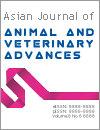肉鸡禽流感病毒(H9N2)的病理和分子研究
Asian Journal of Animal and Veterinary Advances
Pub Date : 2018-04-15
DOI:10.3923/AJAVA.2018.232.244
引用次数: 4
摘要
背景与目的:H9亚型禽流感病毒(AIV)是一种低致病性病毒,通常在肉鸡中造成低死亡率。本研究对2014年10月至2015年1月在埃及达卡利亚省有轻度呼吸道症状的肉鸡养殖场进行血清型H9N2筛查。材料与方法:采用实时聚合酶链反应(RT-PCR)从25个肉鸡养殖场中仅4个养殖场分离到H9N2病毒。血凝素基因(HA)系统发育分析表明,分离株属于鹌鹑/香港/G1/97谱系株,与中东流行的谱系株相似。用pcr阳性的材料在鸡尿囊腔上接种特异性致病性游离胚鸡胚(SPF-ECE)。组织病理学检查后,采用免疫组化法对福尔马林固定石蜡包埋和冷冻组织标本进行H9病毒染色。结果:通过免疫组化染色,在肉鸡的气管、肺、肾以及接种的鸡胚的肝脏和肠道中均可检测到该病毒。结论:H9N2病毒在肉鸡组织中的复制位点与在胚胎中的复制位点不同。然而,由于该病毒本质上是低致病性的,建议埃及家禽养殖户采取生物安全措施以避免暴发。本文章由计算机程序翻译,如有差异,请以英文原文为准。
Pathological and Molecular Studies on Avian Influenza Virus (H9N2) in Broilers
Background and Objective: Avian influenza viruses (AIV) subtype H9 is a low pathogenic virus that usually causes low mortality in the broiler birds. In this study, serotype H9N2 was screened in broiler farms showing mild respiratory manifestations in Dakahlia province, Egypt during the period from October, 2014 to January, 2015. Materials and Methods: H9N2 virus was isolated from only 4 broiler farms out of 25 by real time polymerase chain reaction (RT-PCR). Phylogenetic analysis of the haemagglutinin gene (HA) showed that the isolates were grouped in Quail/Hong Kong/G1/97 lineage-strains similar to the one circulating in the Middle East. Specific pathogenic free-embryonated chicken embryo (SPF-ECE) was inoculated with PCR-positively infected materials on allantoic cavity. Histopathological examination was followed by immunohistochemistry staining of H9 virus in formalin fixed paraffin-embedded and frozen tissue specimens. Results: By immunohistochemistry, the virus was stained in trachea, lungs and kidneys of broiler chickens, in liver and intestine of inoculated chicken embryos. Conclusion: Site of replication of the H9N2 virus in tissues differed in broilers from that in embryos. However, the virus was low pathogenic in nature, the use of biosecurity measures by poultry farmers in Egypt is recommended to avoid outbreaks.
求助全文
通过发布文献求助,成功后即可免费获取论文全文。
去求助
来源期刊

Asian Journal of Animal and Veterinary Advances
生命科学, 兽医学, 基础兽医学, 动物学, 实验动物学
自引率
0.00%
发文量
21
审稿时长
2 months
期刊介绍:
Asian Journal of Animal and Veterinary Advances (AJAVA) is a high-quality peer-reviewed well indexed scientific journal publishing original research findings on all aspects of animal and veterinary sciences. Scope of the journal includes: Pathology, microbiology, parasitology, physiology, pharmacology, veterinary medicine, veterinary anatomy, poultry science, animal genetics and breeding, animal husbandry, animal reproduction and nutrition. Advances in boosting animal production, nutritional strategies, improving growth and production, management practices, genetic improvement, animal biotechnology and biochemistry, embryo biotechnology, veterinary public health and epidemology, countering both infectious pathogens and non-infectious diseases by employing modern diagnostics, vaccines, and effective prevention and control measures will be given priority.
 求助内容:
求助内容: 应助结果提醒方式:
应助结果提醒方式:


